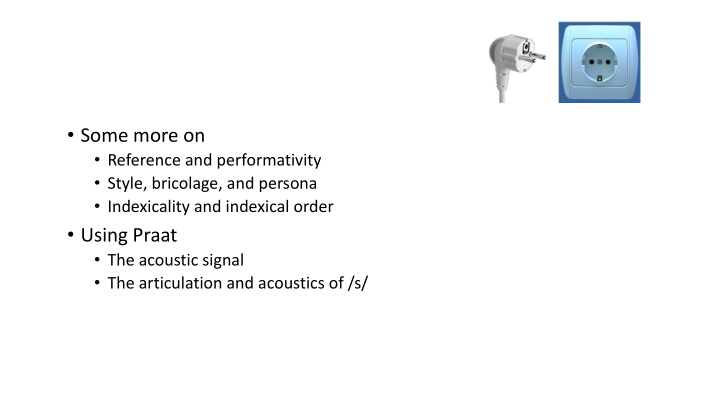



• Some more on • Reference and performativity • Style, bricolage, and persona • Indexicality and indexical order • Using Praat • The acoustic signal • The articulation and acoustics of /s/
I ’ m t o o c o o l f o r t I’m h e r o o m sexy I’m I’m smar art I’m tough I ’ m refined
Performativity is … “… discursive practice that enacts or produces that which it names” Butler, Judith. 1993. Bodies that matter Abingdon: Routledge. Style produces, in the moment, a persona.
Style is manifest ideology Agha, Asif. 2003. The social life of a cultural value. Language and communication 23.231-73.
Bricolage “The scales say ‘alien overlord,’ but the rolled-up sleeves say ‘man of the people.’” the New Yorker Aug. 27, 2012
Resources for linguistic style • Phonetic variation • morpho-syntactic variation • Lexical choice • Discourse markers • Speech acts • Interaction style • Content
Randall this Bush this
Podesva, Robert J., and Janneke Van Hofwegen. 2015. /s/exuality in small-town California: Gender normativity and the acoustic realization of /s/. In Erez Levon and Ronald Mendes (eds.), Language, Sexuality, and Power: Studies in Intersectional Sociolinguistics. Oxford University Press. pp. 168-188.
COG: Age, Gender, and Country Orientation F M Country Town COG (ERB) gender (p < 0.0001) age (p < 0.0096) age * country orientation (p < 0.0113) Age Podesva, Robert J., and Janneke Van Hofwegen. 2015. /s/exuality in small-town California: Gender normativity and the acoustic realization of /s/. In Erez Levon and Ronald Mendes (eds.), Language, Sexuality, and Power: Studies in Intersectional Sociolinguistics. Oxford University Press. pp. 168-188.
/s/ Calder, Jeremy. 2017. Hand/s/ome women: A semiotics of non-normative gender in SOMA, San Francisco. PhD Dissertation. Stanford University.
Possible orders of indexicality n male/female (frequency code?) n+1 male/female masculinity/femininity straight/gay n+1+1 masculinity/femininity southern n+1+1+1 southern country
Potential indexical field for front /s/ gay fierce sissy feminine crisp Others?
(ING) 90 90 80 80 Lower 70 70 % negative concord 60 60 Working % - ə n 50 50 male Lower Middle 40 40 Upper Middle 30 30 20 20 10 10 0 0 umc lmc uwc lwc Casual Careful Reading Labov, W. 1966. The social stratification of Wolfram, Walt. 1969. A sociolinguistic English in New York City Washington, DC: description of Detroit Negro speech Center for Applied Linguistics. Washington DC: Center for Applied Linguistics.
The seduction of numbers What does it mean to say p = .0000 females’ grammar is more 50 standard than males’? 45 40 Does it say something 35 % Negative Concord global about females and 30 25 males? 20 15 Or is it a guidepost to 10 5 what speakers use 0 standard grammar for? Boys Girls Eckert, Penelope. 2000. Linguistic variation as social practice Oxford: Blackwell.
burnouts jocks
Which males and females? 50 45 40 35 % Negative Concord 30 25 20 15 10 5 0 Burnout Girls Burnout Boys Jock Girls Jock Boys
Burned-out burnouts burnouts jocks
Which males and females, jocks and burnouts? 1.4 1.2 1 0.8 Std. Dev. from class mean 0.6 0.4 0.2 0 Burned-out Burnout boys Regular Athlete Jock Non-Athlete Jock girls Burnout girls Burnout girls boys Jock boys -0.2 -0.4 -0.6 -0.8
Recommend
More recommend